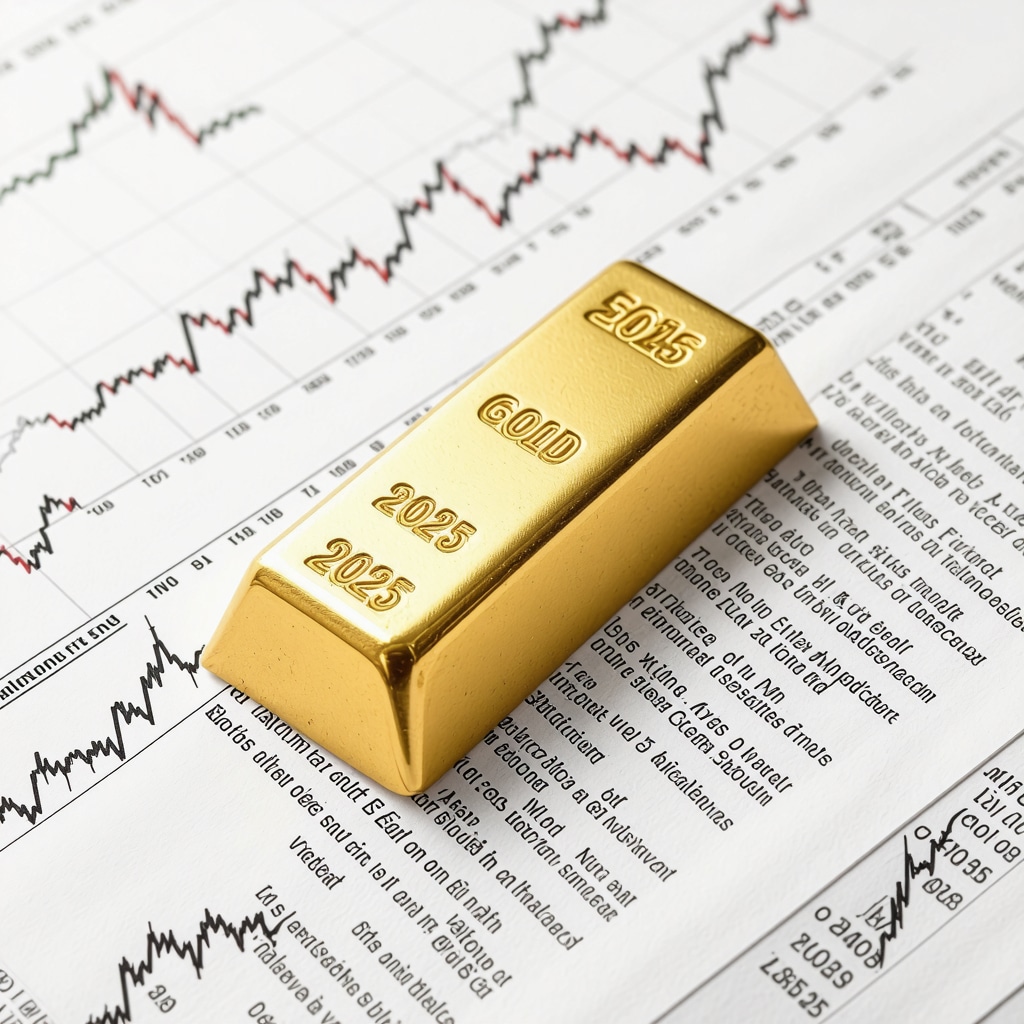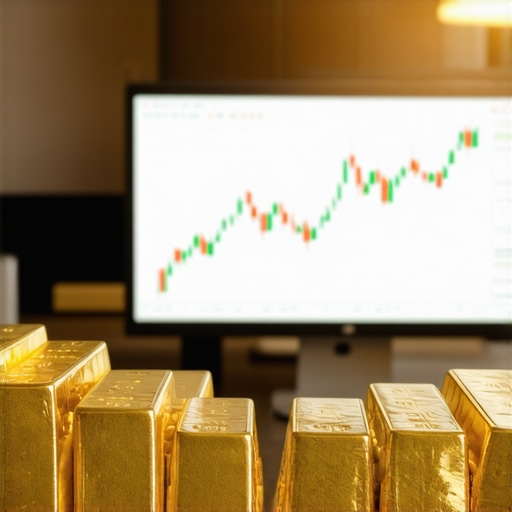Unveiling the Future: Why 2025 Could Be a Pivotal Year for Gold Prices
As investors look ahead to 2025, gold continues to captivate as a resilient asset amid global economic uncertainties. The intricate dance of geopolitical tensions, inflationary pressures, and shifting monetary policies sets the stage for a dynamic gold price landscape. Understanding these forces is essential for investors aiming to navigate the evolving market with confidence and strategic foresight.
Decoding Market Dynamics: The Key Drivers Behind Gold’s 2025 Trajectory
The gold price forecast for 2025 hinges on several critical factors. Central bank policies, particularly shifts in interest rates by the Federal Reserve and other major institutions, remain paramount. Historically, lower real interest rates tend to boost gold’s appeal as a non-yielding asset. Additionally, rising inflation expectations often propel investors toward gold as a reliable inflation hedge. The geopolitical climate, including trade disputes and regional conflicts, further fuels demand as a safe haven.
How Will Central Bank Gold Purchases Influence Prices in 2025?
Central banks have increasingly become strategic players in the gold market, with their purchases directly impacting global supply and demand balances. In 2024, many central banks augmented their reserves, signaling confidence in gold’s long-term value. This trend is expected to continue into 2025, potentially tightening supply and elevating prices. For instance, data from the World Gold Council highlights consistent central bank buying, particularly from emerging economies seeking to diversify reserves away from the U.S. dollar.
Investor Strategies: Aligning Portfolios with Gold’s Emerging Trends
Investors should consider diversified gold investment avenues, including physical bullion, ETFs, and mining stocks. Each offers distinct exposure and risk profiles. For those interested in physical assets, understanding the nuances of buying gold coins versus bars is crucial to maximize security and liquidity. Meanwhile, gold mining stocks can provide leveraged exposure but require careful company selection based on fundamentals and geopolitical risks. For comprehensive insights on gold investment vehicles, explore this expert guide.
Bridging Volatility and Opportunity: Gold as a Strategic Hedge in 2025
Given the anticipated market volatility in 2025, gold’s role as a portfolio stabilizer cannot be overstated. Its low correlation with equities and bonds offers a buffer against downturns, especially during inflationary spikes or geopolitical disruptions. Investors leveraging gold strategically may benefit from enhanced risk-adjusted returns. Practical application of this principle is detailed in this resource, which outlines proven hedging strategies for financial security.
Engage with Us
What are your thoughts on the gold price forecast for 2025? Share your perspectives or questions in the comments below to join our community of informed investors navigating the gold market’s future.
Reference: World Gold Council, “Central Bank Gold Reserves,” 2024 report, available at gold.org.
Unpacking Gold Supply Constraints: How Mining and Recycling Affect 2025 Prices
While central bank purchases significantly influence gold prices, supply-side dynamics play an equally crucial role in shaping the 2025 outlook. Gold mining production growth has been relatively subdued due to geological and operational challenges, with many major mines reaching maturity. This constrained supply, combined with limited new discoveries, tightens market availability. Additionally, the rate of gold recycling, which supplements supply, fluctuates based on price incentives and economic conditions. A dip in recycling activity amid stable prices could further restrict supply, amplifying upward price pressure.
Investors seeking to understand these dynamics may benefit from exploring detailed analyses like those presented in the comprehensive gold supply and demand trends guide.
Gold Market Sentiment: The Psychological Component Impacting 2025 Forecasts
Beyond tangible fundamentals, market sentiment and investor psychology introduce volatility and trend shifts in gold pricing. In times of economic uncertainty or crisis, gold often experiences rapid inflows driven by fear and risk aversion. Conversely, during periods of optimism and strong equity performance, appetite for gold may wane. Monitoring sentiment indicators such as the Commitment of Traders (COT) reports and ETF flow data can provide valuable early signals for market shifts. Skillful interpretation of these metrics is essential for timing entries and exits effectively.
Can Integrating Technical Analysis with Fundamental Insights Enhance Gold Investment Outcomes in 2025?
For sophisticated investors, the question arises: how can combining technical analysis tools with fundamental macroeconomic and geopolitical data improve gold trading and investment decisions in 2025? Technical indicators like moving averages, Relative Strength Index (RSI), and Fibonacci retracements can identify price momentum and potential reversal points. When aligned with fundamental triggers such as central bank announcements or inflation data, these tools assist in crafting nuanced entry and exit strategies. This integrative approach is increasingly favored by professional traders aiming to optimize risk-reward profiles.
Leading financial institutions, including World Gold Council, emphasize that blending analysis methods enhances market understanding and supports more resilient portfolio construction.
Emerging Gold Investment Vehicles: What to Watch in 2025
The gold investment landscape is evolving with innovative products gaining traction. Besides traditional physical gold and ETFs, new vehicles like gold-backed cryptocurrencies and digital tokens are emerging. These offer increased liquidity and accessibility but come with regulatory and security considerations. Investors should weigh these factors carefully and stay informed through trusted sources.
Moreover, gold mutual funds and actively managed gold mining stock portfolios present opportunities for diversification and professional management. To explore tailored options, consider our detailed comparison at investing in gold mutual funds.
Join the Conversation and Deepen Your Gold Market Expertise
How do you integrate fundamental and technical analyses in your gold investment strategy? Share your experiences or pose questions in the comments below to engage with a community of knowledgeable investors focused on capitalizing on gold’s potential in 2025 and beyond.
Harnessing Macro-Financial Interplays: The Subtle Art of Predicting Gold Price Swings in 2025
To sharpen the accuracy of gold price forecasts for 2025, one must delve beyond traditional indicators and embrace the sophisticated interplay of macro-financial variables. The correlation between currency fluctuations—especially the U.S. dollar index—and gold prices remains nuanced. While a weaker dollar typically supports higher gold prices, emerging phenomena such as central bank digital currencies (CBDCs) and unconventional monetary frameworks could disrupt historical patterns. Thus, forecasting models must evolve to incorporate these emerging factors, employing advanced econometric techniques and machine learning algorithms that detect nonlinearities and regime shifts.
Additionally, the global inflation trajectory, influenced by supply chain realignments and energy market volatilities, introduces complex inflation expectations that gold investors must consider. These factors collectively suggest that gold’s 2025 price movements will likely exhibit episodic volatility interspersed with sustained bullish phases, demanding agile portfolio rebalancing and proactive risk management.
Strategic Incorporation of ESG in Gold Mining Investments: Navigating Ethical and Financial Performance
Environmental, Social, and Governance (ESG) criteria have become pivotal in assessing gold mining companies’ viability and investment appeal. In 2025, ESG-compliant mining operations are expected to command premium valuations, driven by increasing regulatory scrutiny and investor demand for sustainable practices. This paradigm shift necessitates a granular evaluation of mining firms’ carbon footprints, water usage, community engagement, and governance structures.
Investors should prioritize companies demonstrating transparent ESG reporting and robust compliance frameworks, which not only mitigate reputational risks but also enhance operational efficiencies. Integrating ESG metrics within fundamental analysis can unearth undervalued opportunities poised for outperformance amid the global push for sustainability.
What Advanced Quantitative Methods Can Enhance Gold Price Forecasting Accuracy in 2025?
Forecasting gold prices with higher precision in 2025 requires leveraging cutting-edge quantitative methodologies that synthesize diverse data sources. Techniques such as vector autoregression (VAR) models, combined with sentiment analysis derived from financial news and social media, can capture market psychology alongside economic fundamentals. Machine learning frameworks—like random forests and neural networks—are particularly adept at detecting complex nonlinear relationships and regime changes in gold pricing.
Moreover, integrating real-time data feeds, including central bank announcements, inflation reports, and ETF flow statistics, into algorithmic trading systems can facilitate timely decision-making. These advanced approaches empower investors to anticipate turning points with greater confidence, optimizing entry and exit strategies within increasingly volatile market environments.
Leading research from the World Gold Council on machine learning in gold price forecasting underscores the potential of these methodologies to transform traditional analysis paradigms.
Emerging Geopolitical Flashpoints: How They Could Reshape Gold’s Safe-Haven Demand in 2025
Geopolitical risk remains a key driver of gold’s safe-haven status, yet 2025 presents a complex global landscape with emerging flashpoints that could dramatically influence demand. Tensions in the Indo-Pacific region, evolving U.S.-China relations, and uncertainties surrounding energy security in Europe are poised to introduce episodic surges in gold buying as investors seek refuge from escalating risks.
Furthermore, cyber warfare and financial sanctions introduce novel dimensions to geopolitical risk, potentially disrupting traditional asset correlations and amplifying gold’s role as a crisis hedge. Navigating these uncertainties requires continuous geopolitical intelligence and scenario analysis to anticipate market reactions and adjust investment postures accordingly.
Engage Deeper: Leverage Our Expertise for Tailored Gold Investment Insights
Are you ready to incorporate advanced analytics and ESG considerations into your 2025 gold investment strategy? Join our expert-led webinars and access proprietary research that dissects these complex dynamics in actionable detail. Share your questions and strategies in the comments below to collaborate with seasoned professionals dedicated to navigating the evolving gold market landscape.
Enhancing Predictive Models: The Role of Alternative Data in Gold Price Analysis
In the realm of gold price forecasting, traditional economic indicators provide a foundational perspective, yet the integration of alternative data sources such as satellite imagery of mining activities, shipping logs for gold transport, and social media sentiment analytics offers a cutting-edge advantage. These data streams enable analysts to detect supply chain disruptions and shifts in investor mood well before they manifest in price movements, thus refining the timing and accuracy of forecasts for 2025.
Climate Change Impact on Gold Mining: Unseen Risks and Opportunities
As climate change intensifies, its ramifications for gold mining operations are becoming increasingly pronounced, influencing production costs and regulatory landscapes. Water scarcity, extreme weather events, and stricter environmental regulations challenge mining firms’ operational resilience. Conversely, companies adopting innovative, eco-friendly technologies are positioned to outperform peers, attracting ESG-focused capital inflows. Investors must therefore incorporate climate risk assessments into their gold mining investment frameworks to anticipate potential disruptions and identify sustainable value creators.
How Can Machine Learning Algorithms Adapt to Sudden Geopolitical Shocks Affecting Gold Prices?
Machine learning (ML) algorithms, while adept at modeling historical patterns, often confront challenges in adapting to unforeseen geopolitical shocks that abruptly alter gold price trajectories. Incorporating real-time news feeds, anomaly detection systems, and reinforcement learning techniques enables ML models to dynamically recalibrate in response to evolving geopolitical landscapes. This adaptability enhances the robustness of trading strategies amid the episodic volatility expected in 2025.
For a comprehensive exploration of these advanced methodologies, the World Gold Council’s recent report on machine learning in gold price forecasting remains an authoritative resource.
Strategic Portfolio Integration: Balancing Gold with Emerging Alternative Assets
Beyond gold, emerging alternative assets such as tokenized commodities and blockchain-based financial products are reshaping portfolio diversification paradigms. Incorporating gold alongside these assets requires sophisticated risk modeling to capture correlations and liquidity profiles accurately. Advanced portfolio optimization techniques, including multi-factor stress testing and scenario analysis, empower investors to harness gold’s unique hedging properties while capitalizing on innovation-driven growth sectors.
Invitation to Advanced Investors: Collaborate and Innovate in Gold Market Strategies
We invite seasoned investors and analysts to engage deeply with these advanced insights and contribute to a collaborative knowledge exchange. Share your sophisticated forecasting models, ESG integration approaches, or innovative hedging tactics in the comments below. Together, we can navigate the complexities of the 2025 gold market and unlock its full strategic potential.
Frequently Asked Questions (FAQ)
What fundamental factors most significantly influence gold prices in 2025?
Gold prices in 2025 are primarily driven by central bank policies (especially interest rate decisions), inflation expectations, geopolitical tensions, and supply-demand dynamics including mining output and recycling rates. These macroeconomic and geopolitical factors create the framework within which gold acts as a safe haven and inflation hedge.
How do central bank gold purchases affect the market outlook for 2025?
Central banks, particularly from emerging markets, have been steadily increasing gold reserves to diversify away from fiat currencies. This ongoing accumulation reduces available supply and signals confidence, thereby exerting upward pressure on prices. Their strategic buying behavior is a key factor in tightening supply-demand balance forecasted for 2025.
What role does ESG play in evaluating gold mining investments?
ESG considerations have become crucial in assessing gold mining companies. Investors now prioritize firms with strong environmental stewardship, social responsibility, and good governance to mitigate risks and tap into premium valuations. ESG-compliant miners tend to be more resilient amid regulatory and societal pressures, making them attractive for sustainable investment strategies.
Can technical analysis improve gold investment decisions alongside fundamental analysis?
Yes. Integrating technical indicators (such as moving averages and RSI) with fundamental data (like inflation trends and geopolitical events) enhances timing and risk management. This combined approach helps identify momentum shifts and entry/exit points, increasing the precision and effectiveness of gold trading strategies in volatile markets.
How are emerging technologies like machine learning changing gold price forecasting?
Machine learning models incorporate vast, heterogeneous data including economic indicators, sentiment analysis, and alternative data sources to detect complex patterns and regime shifts beyond traditional methods. This enables more adaptive, real-time forecasting that can better anticipate turning points and sudden shocks in gold prices.
What impact could geopolitical risks have on gold’s safe-haven demand in 2025?
Geopolitical flashpoints such as tensions in the Indo-Pacific, U.S.-China relations, and cyber warfare can trigger episodic surges in gold buying as investors seek crisis protection. These risks amplify gold’s role as a hedge against market instability and often lead to increased volatility and price spikes.
How might alternative data sources improve the precision of gold price analysis?
Alternative data like satellite imagery of mining sites, shipping logs, and social media sentiment provide early warnings of supply disruptions or shifts in investor mood. Integrating these real-time, non-traditional data streams refines the timing and accuracy of forecasts, offering a competitive edge in rapidly evolving markets.
What challenges do climate change pose to gold mining operations and investments?
Climate change introduces risks such as water scarcity, extreme weather, and stricter environmental regulations, which can increase operational costs and disrupt production. However, miners adopting sustainable technologies are better positioned to benefit from ESG-driven capital flows and regulatory compliance, representing both risks and opportunities for investors.
How should investors balance gold with emerging alternative assets in 2025 portfolios?
Investors incorporating gold alongside new asset classes like tokenized commodities and blockchain-based products should utilize advanced portfolio optimization and risk modeling to capture diverse correlations and liquidity profiles. This balanced approach enhances diversification while leveraging gold’s traditional hedging benefits amid innovation-driven growth sectors.
What strategies can investors use to hedge volatility in 2025 using gold?
Investors can employ a mix of physical gold, ETFs, mining stocks, and derivatives to strategically hedge against inflation, currency fluctuations, and geopolitical risk. Combining fundamental and technical analyses improves timing, while ESG-focused mining investments can add resilience. Dynamic portfolio rebalancing aligned with market conditions further enhances risk-adjusted returns.
Trusted External Sources
- World Gold Council (WGC): The WGC provides comprehensive research on gold demand, supply, market trends, and investment strategies, including in-depth reports on central bank reserves, ESG integration, and machine learning applications in gold price forecasting.
- International Monetary Fund (IMF): Offers authoritative macroeconomic data, monetary policy analysis, and global financial stability reports that contextualize gold’s role as a reserve asset and safe haven.
- US Geological Survey (USGS): Supplies detailed statistics on gold mining production, reserves, and recycling trends critical for understanding supply-side constraints impacting prices.
- Bloomberg Terminal and Refinitiv Eikon: Leading financial data platforms delivering real-time market sentiment indicators, ETF flows, and geopolitical risk analytics essential for technical and sentiment-driven analysis.
- Journal of Sustainable Finance & Investment: Publishes peer-reviewed research on ESG factors in mining and their financial implications, supporting informed sustainable investment decisions.
Conclusion
The gold price forecast for 2025 is shaped by a sophisticated interplay of macroeconomic policies, geopolitical uncertainties, supply constraints, and evolving investor preferences towards sustainability and technology-driven analysis. Central bank demand, inflation dynamics, and emerging ESG standards are set to drive gold’s market trajectory, while innovative forecasting methods like machine learning enhance predictive accuracy amid episodic volatility. For investors, strategically integrating fundamental insights with technical analysis and incorporating ESG considerations in mining investments offers a robust pathway to harness gold’s enduring value as a hedge and portfolio stabilizer. Embracing these comprehensive perspectives equips investors to navigate the complex 2025 gold landscape adeptly.
We invite you to share your insights, questions, or advanced strategies in the comments and explore our related expert content to deepen your mastery of gold investing in an ever-evolving global market.











I found the discussion on central bank gold purchases particularly insightful, especially given recent trends in emerging markets diversifying reserves. From my experience, these large-scale acquisitions can indeed tighten supply and serve as a bullish signal for prices in the short to medium term. However, I wonder how the potential introduction of digital currencies by major central banks might influence or disrupt this dynamic? Could it reduce traditional gold demand if digital assets gain prominence? It would be interesting to see how these technological shifts are factored into future forecasts. Overall, I agree that supply constraints coupled with geopolitical tensions make gold an intriguing hedge, but staying updated with macroeconomic developments and new policy moves remains crucial. How do others think the rise of CBDCs and digital payments might shape the gold market in 2025 and beyond?